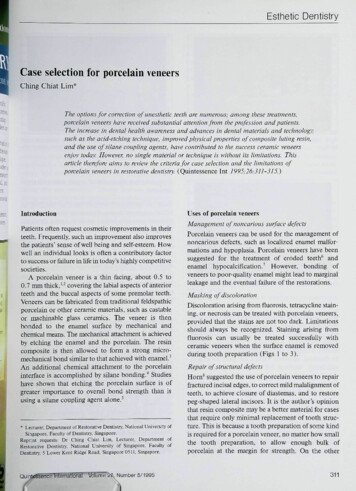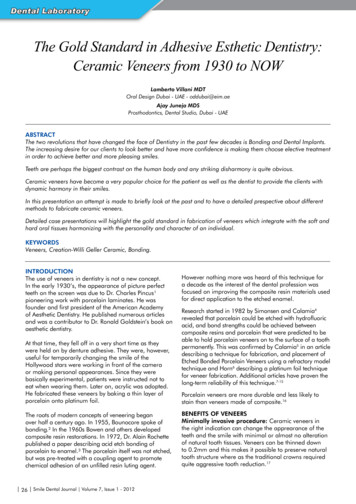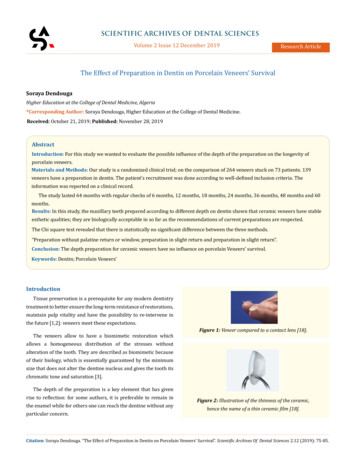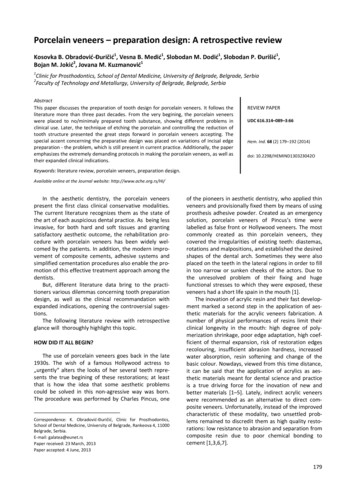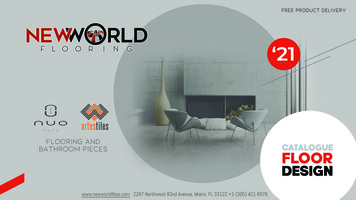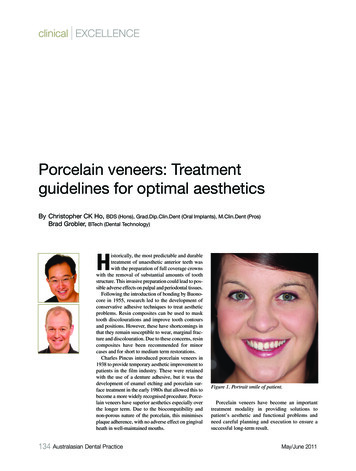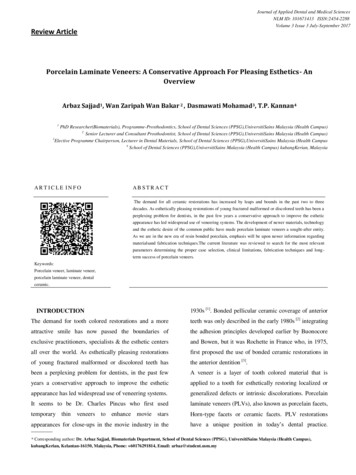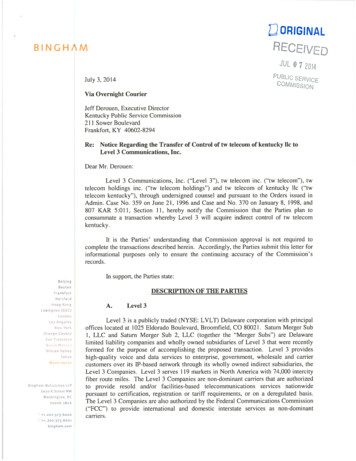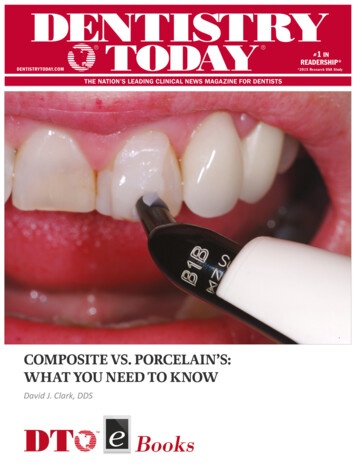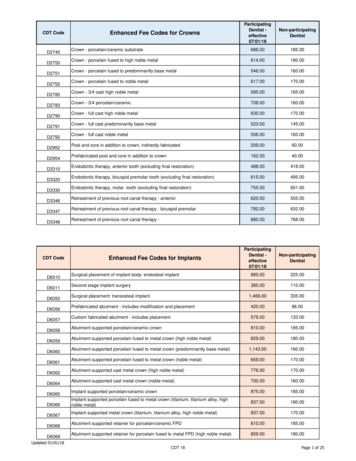
Transcription
ReviewsPorcelain veneers: An updateLicówki porcelanowe – uaktualnienie wiedzyOmar El-Mowafy1,A,C,D,F, Nihal El-Aawar1,B, Nora El-Mowafy2,E12Faculty of Dentistry, University of Toronto, CanadaDepartment of Oral Health Sciences, University of British Columbia, Vancouver, CanadaA – research concept and design; B – collection and/or assembly of data; C – data analysis and interpretation;D – writing the article; E – critical revision of the article; F – final approval of the articleDental and Medical Problems, ISSN 1644-387X (print), ISSN 2300-9020 (online)Address for correspondenceOmar El-MowafyE-mail: Omar.El-Mowafy@dentistry.utoronto.caFunding sourcesNone declaredConflict of interestNone declaredReceived on March 8, 2018Reviewed on April 4, 2018Accepted on May 4, 2018Dent Med Probl. 2018;55(2):207–211AbstractNew glass-ceramic restorative materials have been developed over the last few years, with enhancedstrength characteristics along with desirable optical properties that make them ideal for the fabricationof esthetic crowns and veneers. The purpose of this paper was to provide an overview of the current stateof the art of porcelain veneers as a viable option for the esthetic treatment of anterior teeth, and to illustratethe potential of the newly-developed glass-ceramics. Some historical background about the developmentof the porcelain veneer concept is provided. A list of indications and contraindications for porcelain veneersis followed by their preparation designs, with emphasis on the importance of maintaining the preparationboundaries within the enamel. Impression-taking procedures, provisional restoration fabrication, the choiceof porcelain materials and their intaglio surface treatment are all discussed. A case where veneers madewith a lithium-disilicate glass-ceramic were used to improve the appearance of maxillary anterior teethis included. Several studies reporting on the longevity of porcelain veneers up to 12 years are discussed.Key words: glass-ceramic, update, dental porcelain, longevitySłowa kluczowe: tworzywo szklano-ceramiczne, uaktualnienie wiedzy, ceramika dentystyczna, trwałośćDOI10.17219/dmp/90729Copyright 2018 by Wroclaw Medical Universityand Polish Dental SocietyThis is an article distributed under the terms of theCreative Commons Attribution Non-Commercial nd/4.0/)
208Porcelain veneers are thin-bonded ceramic prosthetics that restore the facial surface and part of the proximalsurfaces of anterior teeth that require esthetic treatment.1They typically consist of thin shells of porcelain, the fittedsurface of which has been etched with hydrofluoric acidand coated with a silane coupling agent. Using a resinbased cement, the veneer is bonded to enamel that hasbeen prepared with a phosphoric acid etchant.2 Due totheir high esthetic appeal, as well as their proven biocompatibility and long-term predictability, porcelain veneershave become a reliable restorative procedure for the treatment of teeth in the front area of the mouth.3,4Porcelain veneers were introduced to the profession byJohn Calamia of New York University, USA, in the early1980s.5,6 Their development was one of several innovations and outcomes that followed the discovery of acidetching and bonding to enamel that was first reported byMichael Buonocore in the 1950s.7 Resin composite formulations based on bisphenol A-glycidyl methacrylate (BisGMA) were introduced to the profession by Rafael Bowenin the early 1960s.8 These resulted in composite restorations with superior physical and mechanical properties,leading to enhanced clinical performance. Following thesuccess of these resin-based restorative composites, resincements based on Bis-GMA resin were introduced to theprofession in the late 1970s. This meant that 3 crucial elements for the development of the porcelain veneer technique had been realized: the ability to acid-etch enamelto produce a microscopically rough surface that is receptive to bonding; the ability to acid-etch the fitted surfaceof a feldspathic porcelain veneer with hydrofluoric acid tocreate a microscopically rough surface that is also receptive to bonding to the resin; and the availability of a resincement that can be used for cementing porcelain veneersto enamel.9Indications and contraindicationsfor porcelain veneersPorcelain veneers are ideal for the treatment of discolored vital anterior teeth that do not respond well tobleaching. This includes moderate discoloration causedby tetracycline staining, excessive fluoride uptake, aging,and amelogenesis imperfecta.10 Enamel hypocalcificationand fractures can also be corrected with porcelain veneers.5,6,11 They are also useful for closing moderate spacing between anterior teeth and to treat congenital toothmalformation.12 When there is a need to lengthen or reshape maxillary anterior teeth, porcelain veneers providea conservative treatment option.13,14In contrast, endodontically-treated anterior teeth thatare structurally compromised are not suitable candidatesfor porcelain veneers, as they need the bracing providedby full-coverage crowns to maintain their integrity. Heavily-restored teeth with inadequate enamel are not goodO. El-Mowafy, N. El-Aawar, N. El-Mowafy. Porcelain veneerscandidates either, as enamel is the main source of retention for porcelain veneers. Other precluding conditionsare dentition lacking posterior support, poor oral hygieneand existing parafunctional activity, such as bruxism.15,16Magne et al. reported that success rates for porcelainveneers drop to 60% in patients with bruxism activity;however, this percentage was similar to that obtained formetal-ceramic crowns used in the same situation.17PreparationPorcelain veneer preparation is characterized by minimal removal of the tooth structure. Ideally, porcelain veneer preparation should be confined to enamel in termsof the periphery and depth. For maxillary anterior teeth,typical preparation involves the whole facial (labial) surface to a depth of approx. 0.3 mm. In some cases, whenthere is a need to lengthen the teeth or close interproximal spaces, an incisal and/or proximal wrap-around isindicated. However, the key for proper retention of porcelain veneers is to keep the preparation within theenamel structure. This will ensure superior bonding andwill allow avoiding the potential for postoperative sensitivity, which may happen if the dentin is involved in thepreparation. The finish line of the preparation is typicallyof the feather-edge type, considering the minimal amountof enamel removed. Gingivally, it terminates at the gingival margin. An incisal overlap is performed only whenneeded. It can either be extended as a palatal chamfer ormerely as a horizontal incisal reduction (a butt joint).Porcelain veneer preparations have the advantage of being significantly more conservative than full-coveragecrowns, and can address some of the limitations of metalceramic full-coverage crowns.18 The advantages includesuperior optical reflectance due to the elimination of themetallic core; the ability to place margins supragingivally;and improved gingival tissue response as compared tothat caused by by some elements in base metal alloys.19Impression-taking for porcelainveneersA vinyl poly-siloxane-based impression material is typically used in a custom or stock tray for veneer impressionpreparation. The retraction cord is positioned to exposethe finish line. For computer-aided-designed and computer-aided-manufactured (CAD-CAM) veneers, a digital impression is made with an appropriate scanner.The temporization of tooth preparation for porcelainlaminate veneers is advocated in order to maintain thepatient’s appearance unchanged and for the overall success of the restoration.20 However, in some cases, providing provisional restorations may be optional. Sincethe preparations involve enamel only, the risk of postop-
Dent Med Probl. 2018;55(2):207–211erative sensitivity is non-existent, and since contacts between the teeth are not always broken during the preparation, the risk of tooth shifting is remote. However, whena case dictates the use of provisional restorations, theseshould be made as one piece, with no attempt to separateindividual provisional veneers. This ensures better retention by engaging the interproximal areas, and at the sametime maintains the strength of the restorations, whichare rather thin and delicate. One technique for cementing temporary porcelain veneers involves spot-etchingat the center of the facial surface, followed by applyinga bonding resin at the etched point only and using a smallamount of a resin cement for attachment. The use of ordinary temporary cements, which are naturally opaque,adversely affects the final esthetic outcome of temporaryveneers due to their ultra-thin nature, which allows thecement opacity to show through.209opacity blocks are becoming available and can help toovercome this limitation. Figure 1 shows 6 maxillaryincisors with discoloration and gingival recession. Theright lateral incisor had previously been restored witha ceramo-metal crown. Figure 2 shows a postoperative view with 1 crown and 5 veneers made with millede.Max (Ivoclar Vivadent AG, Schaan, Liechtenstein)lithium disilicate glass-ceramic and cemented into placewith a resin cement.Types of porcelain used forporcelain veneer fabricationTraditionally, veneers are fabricated using the manuallayering technique from feldspathic porcelain. This necessitates the use of refractory dyes to support the condensed layers of the porcelain slurry.11 This techniquepermits the use of layers with multiple levels of opacity,resulting in optimum esthetics. However, the process istechnique-sensitive, and manual mixing and layeringof the porcelain may result in the incorporation of smallvoids.21 These voids may cause crack lines or even a fracture to occur over time.Alternatively, pressed porcelain has been used for thefabrication of veneers.22 The main advantages of pressedporcelain are that the resulting veneers have a high levelof accuracy and minimal internal structural defects.23Recently, CAD-CAM veneers from glass-ceramicblocks have become available, and their utilization is onthe rise. While such veneers are significantly strongerthan feldspathic porcelain ones, the color of many of theblocks available is of single opacity.24 However, multi-Fig. 1. Maxillary anterior teeth with gingival recession and discolorationFig. 2. Five lithium disilicate glass-ceramic e.Max veneers and 1 crown weremade according to a diagnostic mock-up approved by the patient. These werecemented with a light-polymerized resin cementSurface treatmentand cementationAcid etching of the fitted surface with hydrofluoric acidhas become the standard procedure to render the fitted surface microscopically rough.25–27 A silane couplingagent is applied to the etched surface to enhance bonding to the resin cement.28 For an optimal ceramic–cementbond, sandblasting the ceramic surfaces with aluminumoxide particles prior to acid-etching with hydrofluoricacid is recommended.29Silane facilitates the adhesion between the inorganicsubstrate (porcelain) and the organic polymers (resin cement) by increasing porcelain wettability and interlocking.30 Moreover, silane is a bifunctional molecule thatchemically bonds to the hydrolyzed silicon dioxide of theceramic surface on one side and to the methacrylate groupof the resin cement on the other side.31The attachment of porcelain veneers to the teeth depends on bonding to enamel. An appropriate resin cement is used to achieve this, and to help seal the marginsof the veneers, reinforcing the ceramic structure and providing an opportunity to modify the color of the restoration if needed.32,33 A light-polymerized resin cement is theonly type of resin cement that can be used with porcelainveneers. This is because self-polymerized and dual-polymerized resin cements can darken with time, leading toundesirable changes in the color of the veneer.
210As porcelain veneers are very thin, they must be handled carefully during the try-in and subsequent cementation. Excessive finger pressure may cause the veneer tofracture, particularly when a high-viscosity resin cementis used. Low film thickness is desirable for optimum adaptation to the tooth substrate.32,33 Seating the restorationswith ultrasonic energy has been recommended.34 The vibrations, based on the oscillation principles of the ultrasonic device, are helpful in altering the viscosity of the cement, which settles the restoration into place, spreadingthe luting agent under the restoration and minimizing thepotential for future leakage.35–37An important key to success is proper occlusal adjustment after the porcelain veneers are cemented. Occlusionshould first be checked in the centric position, and any contacts on the lingual aspects of the newly-cemented veneersmust be removed. Similarly, occlusion must be checked inthe protrusive mandibular excursion, and any contacts onthe lingual aspects of the veneers must be removed. This willensure that the veneers will be subjected to minimal compressive/shear forces, which is important for their longevity.Gingival tissue responseto porcelain veneersPorcelain veneers are typically associated with favorablegingival tissue response due to the location of their gingivalmargin, which is typically at the gumline or slightly supragingival to the tissues. A proper emergence profile contributes to lowering the incidence of plaque retention, thushelping in the maintenance of periodontal health.38 Theperiodontal response to porcelain veneers reported in theliterature varies from clinically acceptable to excellent.39Longevity of porcelain veneersThe long-term success of porcelain veneers dependson careful case selection, the design of tooth preparation,the material, the laboratory fabrication, and the insertion procedure. Several studies reporting on the longevityof porcelain veneers have been published. Fradeani et al.stated that feldspathic porcelain and glass-infiltrated ceramic veneers presented survival rates ranging from 96%to 98% at a 5-year evaluation.40 Similarly, Della Bona andKelly reported overall failure rates for ceramic veneersof less than 5% at 5 years.41D’Arcangelo et al. reported that 119 porcelain veneers hada survival rate of 97.5% at a 7-year evaluation.42 In a retrospective study by Gurel et al., evaluating 580 porcelain veneers with various preparation designs for a 12-year period,an overall survival rate of 86% was observed.43 The mostfrequently observed type of failure was a veneer fracture.Preparations with margins on dentin were 10 times morelikely to lead to failure than those with margins on enamel.O. El-Mowafy, N. El-Aawar, N. El-Mowafy. Porcelain veneersBeier et al. stated that porcelain veneers offer predictable and successful restoration with an estimated survivalrate of more than 10 years.44 Layton and Walton reportedthe longevity of feldspathic porcelain veneers as up to 12years; at 5 years, the survival rate was 96%, dropping to93% at 10 years and to 91% at 12 years.45 A cumulativesuccess rate of approx. 93% was reported after a 15-yearretrospective clinical observation.46 In a 10-year prospective clinical trial that involved 87 porcelain veneers, noneof the veneers were lost. At 5 years, 92% remained in usewithout the need for clinical intervention; however, at 10years, the percentage dropped to 64%.47 Large marginaldefects were the main failure mode (20%), particularlywhen the veneer ended on an existing composite restoration; a porcelain fracture (11%) was the next most frequentfailure. Only 4% of the veneers needed to be replaced atthe 10-year mark.In a recent systematic review by Morimoto et al., 899studies were identified, but only 13 were analyzed.48 Anoverall survival rate of 89% at 9 years was reported; thesurvival of glass-ceramic veneers (94%) was higher thanthat of feldspathic porcelain veneers (87%). Failure modesincluded debonding (2%), a fracture (4%), caries (1%), anddiscoloration (2%). Figure 3 shows a case of a fracturedporcelain veneer on a canine.Calamia and Calamia enumerated keys to success forporcelain veneers that may lead to their survival for upto 25 years.49 These included proper treatment planning,preparations terminating in enamel, proper selectionof the ceramic to be used, and proper cementation.In conclusion, porcelain veneers have been used in theprofession for more than 30 years. They are characterized by a conservative preparation design with minimalenamel reduction. Proper case selection is key for theirsuccess. Several studies have indicated a high survivalrate over the long term. When failure occurs, it frequentlyinvolves a veneer fracture. The introduction of milledglass-ceramic materials is expected to overcome the fracture issue due to the enhanced strength of this material ascompared to the original feldspathic formulations.Fig. 3. Maxillary left canine with a vertical fracture of a feldspathic porcelainveneer that took place several years after cementation
Dent Med Probl. 2018;55(2):207–211References1. The glossary of prosthodontics. J Prosthet Dent. 2017;117:E70.2. Burke FJ. Survival rate for porcelain laminate veneers with special references to the effect of preparation in dentin: A literaturereview. J Esthet Restor Dent. 2012;24:257–265.3. Aykor A, Ozel E. Five-year clinical evaluation of 300 teeth restoredwith porcelain laminate veneers using total-etch and a modifiedself-etch adhesive system. Oper Dent. 2009;34:516–523.4. Goldstein RE. Esthetics in Dentistry. Vol. 1. Principles, Communications, Treatment Methods. 2nd ed. Hamilton, Canada: BC Decker Inc.;1998:14.5. Calamia JR. Etched porcelain facial veneers: A new treatmentmodality based on scientific and clinical evidence. NY J Dent.1983;53:255–259.6. Calamia JR. Etched porcelain veneers: The current state of the art.Quintessence Int. 1985;16:5–12.7. Buonocore MG. A simple method of increasing the adhesion of acrylicfilling materials to enamel surfaces. J Dent Res. 1955;34:849–853.8. Bowen RL. Properties of a silica-reinforced polymer for dental restoration. J Am Dent Assoc. 1963;66:57–64.9. Addison O, Marquis PM, Fleming GJ. Adhesive luting of all-ceramicrestorations: The impact of cementation variables and short-termwater storage on the strength of a feldspathic dental ceramic.J Adhes Dent. 2008;10:285–293.10. Jankar AS, Kale Y, Kangane S, Ambekar A, Sinha M, Chaware S. Comparative evaluation of fracture resistance of ceramic veneer withthree different incisal design preparations: An in vitro study. J IntOral Health. 2014;6:48–54.11. Horn HR. Porcelain laminate veneer bonded to etched enamel:A review. Dent Clin North Am. 1983;27:671–684.12. Strassler HE. Minimally invasive porcelain veneer: Indications fora conservative esthetic dentistry treatment modality. Gen Dent.2007;55:686–712.13. Cehreli MC, Iplikçioglu H. Five-year follow-up of InCeram laminaterestorations: A clinical report. J Prosthet Dent. 2000;84:487–489.14. Freire A, Archegas LR. Porcelain laminate veneer on a highly discolored tooth: A case report. J Can Dent Assoc. 2010;76:a126.15. Walls AWG. The use of adhesively retained all-porcelain veneers during the management of fractured and worn anterior teeth. Part 2. Clinical result after five-years follow-up. Br Dent J. 1995;178:337–340.16. Peumans M, Van Meerbeeck B, Yoshida Y, Lambrechts P, Vanherle G. Five-year clinical performance of porcelain veneers. Quintessence Int. 1998;29:211–221.17. Magne P, Perroud R, Hodges JS, Belser UC. Clinical performanceof novel-design porcelain veneers for the recovery of coronal volumeand length. Int J Periodontics Restorative Dent. 2000;20:440–457.18. Chen W, Raigrodski AJ. A conservative approach for treating youngadult patients with porcelain laminate veneers. J Esthet Restor Dent.2008;20:223–238.19. Pippin DJ, Mixson JM, Soldan-Els AP. Clinical evaluation of restoredmaxillary incisors: Veneers vs PFM crowns. J Am Dent Assoc.1995;126:1523–1529.20. Kumar Vinod G, Soorya Poduval T, Reddy B, Shesha Reddy P.A study on provisional cements, cementation techniques, and theireffects on bonding of porcelain laminate veneers. J Indian Prosthodont Soc. 2014;14:42–49.21. Taskonak B, Anusavice K, Mecholsky J. Role of investment interaction layer on strength and toughness of ceramic laminates. DentMater. 2004;20:701–708.22. Shuman IE. Esthetic treatment with a pressed ceramic veneermaterial: Case reports. Dent Today. 2004;23:80–84.23. Mormann WH. The evolution of CEREC system. J Am Dent Assoc.2006;137(Suppl):7S–13S.24. Vafiadis D, Goldstein G. Single visit fabrication of a porcelain laminate veneer with CAD/CAM technology: A clinical report. J ProsthetDent. 2011;106:71–74.25. Stangel I, Nathanson D, Hsu CS. Shear strength of the compositebond to etched porcelain. J Dent Res. 1987;66:1460–1465.26. Kursoglu P, Motro PFK, Yurdaguven H. Shear bond strength of resincement to an acid etched and a laser irradiated ceramic surface.J Adv Prosthodont. 2013;5:98–103.21127. Valian A, Moravej-Salehi E. Surface treatment of feldspathic porcelain: Scanning electron microscopy analysis. J Adv Prosthodont.2014;6:387–394.28. Aida M, Hayakawa T, Mizukawa K. Adhesion of composite to porcelainwith various surface conditions. J Prosthet Dent. 1995;73:464–470.29. Kato H, Matsumura H, Tanaka T, Atsuta M. Bond strength and durabilityof porcelain bonding systems. J Prosthet Dent. 1996;75:163–168.30. Blatz MB, Sadan A, Kern M. Resin–ceramic bonding: A review of theliterature. J Prosthet Dent. 2003;89:268–274.31. Meshramkar R, Sajjan S. A comparative evaluation of shear bondstrength of porcelain and composite using different bondingagents: An in vitro study. J Indian Prosthodont Soc. 2010;10(1):36–40.32. Rosentritt M, Behr M, Kolbeck C, Handel G. Marginal integrityof CAD/CAM fixed partial dentures. Eur J Dent. 2007;1:25–30.33. Touati B, Miara P. Light transmission in bonded ceramic restorations. J Esthet Dent. 1993;5:11–18.34. Cantoro A, Goracci C, Coniglio I, Magni E, Polimeni A, Ferrari M.Influence of ultra-sound application on inlay luting with self-adhesive resin cements. Clin Oral Investig. 2011;15:617–623.35. Judge RB, Wilson PR. The effect of oscillating forces upon the flowof dental cements. J Oral Rehabil. 1999;26:892–899.36. Schmidlin PR, Zehnder M, Schup-Mityko C, Gohring TN. Interfaceevaluation after manual and ultrasonic insertion of standardizedclass I inlays using composite resin materials of different viscosity.Acta Odontol Scand. 2005;63:205–212.37. Peutzfelt A. Effect of the ultrasonic insertion technique on the seating of composite inlays. Acta Odontol Scand. 1994;52:51–54.38. Reeves WG. Restorative margin placement and periodontal health.J Prosthet Dent. 1991;66:7333–7336.39. Shuman IE. Esthetic treatment with a pressed ceramic veneermaterial: Case reports. Dent Today. 2004;23:80–84.40. Fradeani M, Redemagni M, Corrado M. Porcelain laminate veneers:6- to 12-year clinical evaluation. A retrospective study. Int J Periodontics Restorative Dent. 2005;25:9–17.41. Della Bona A, Kelly JR. The clinical success of all-ceramic restorations. J Am Dent Assoc. 2008;139(Suppl):8–13.42. D’Arcangelo C, De Angelis F, Vadini M, D’Amario M. Clinical evaluation on porcelain laminate veneers bonded with light-cured composite: Results up to 7 years. Clin Oral Investig. 2012;16:1071–1079.43. Gurel G, Sesma N, Calamita MA, et al. Influence of enamel preservation on failure rates of porcelain laminate veneers. Int J PeriodonticsRestorative Dent. 2013;33:31–39.44. Beier US, Kapferer I, Burtscher D, Dumfahrt H. Clinical performanceof porcelain laminate veneers for up to 20 years. Int J Prosthodont.2012;25:79–85.45. Layton D, Walton T. An up to 16-year prospective study of 304 porcelain veneers. Int J Prosthodont. 2007;20:389–396.46. Friedman MJ. A 15-year review of porcelain veneer failure: A clinician’s observations. Compend Contin Educ Dent. 1998;19:625–636.47. Peumans M, De Munck J, Fieuws S, Lambrechts P, Vanherle G,Van Meerbeek B. A prospective ten-year clinical trial of porcelainveneers. J Adhes Dent. 2004;6:65–76.48. Morimoto S, Albanesi RB, Sesma N, Agra CM, Braga MM. Main clinical outcomes of feldspathic porcelain and glass-ceramic laminateveneers: A systematic review and meta-analysis of survival complication rates. Int J Prosth. 2016;29:38–47.49. Calamia JR, Calamia CS. Porcelain laminate veneers: Reasons for 25years of success. Dent Clin North Am. 2007;51:399–417.
Porcelain veneers are thin-bonded ceramic prosthet-ics that restore the facial surface and part of the proximal surfaces of anterior teeth that require esthetic treatment. 1 They typically consist of thin shells of porcelain, the fitted surface of which has been etched with hydrofluoric acid
